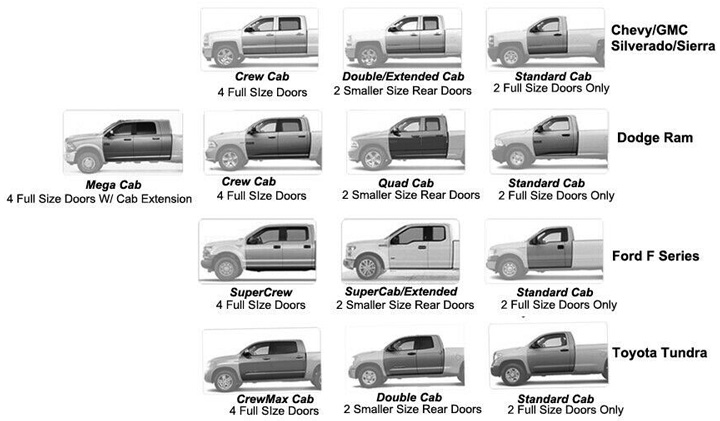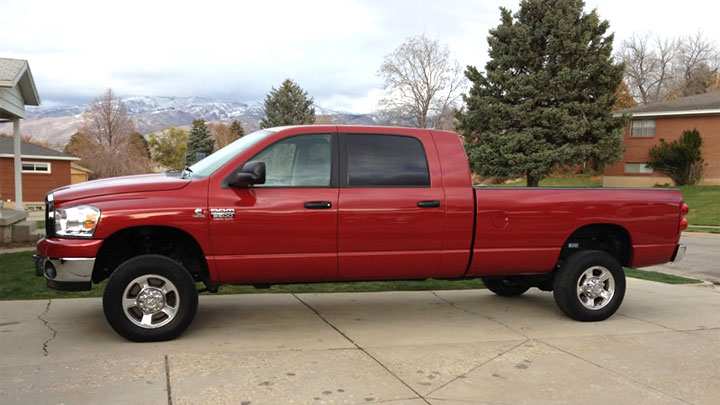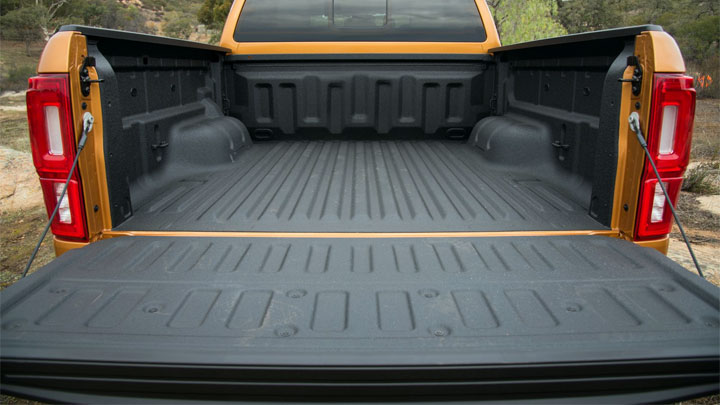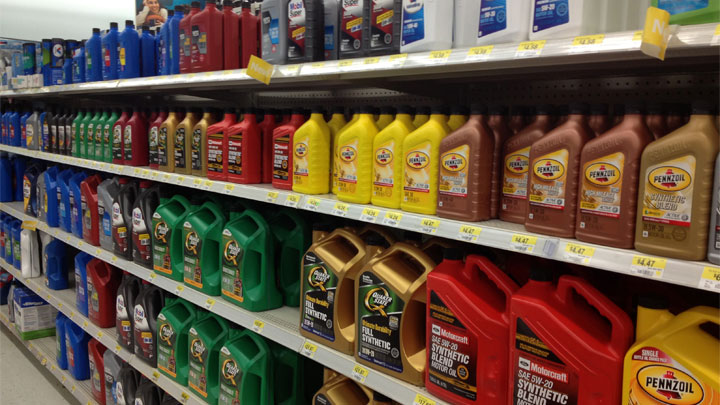Last Updated on October 25, 2021
Do you need a large truck because you are a “mountain man”? You’re just looking to get out there in the wilderness, do some 4 x 4 driving, and haul cords of lumber because you live out in the country and a truck is the only way to get it done.
If you want to haul around your truck bed camper because you’re going out hunting, or you just need to tow your future airstream trailer down the road because you want to take your family camping. These are all great reasons to get a truck, and in effect, get a truck bed.
But what size of truck should you get? Keep reading to learn about truck bed sizes and cab sizes so you don’t buy a truck you’ll regret.
See Also: Top 10 Diesel Engines
Truck Bed Sizes
Extra-Short Bed
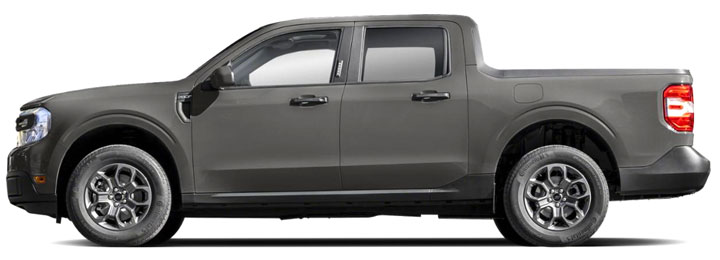
These are the beds that most “truck people” frown upon. “They are way too short to get any sort of real work done.” is something you might hear. People will constantly ridicule your super short bed but as they’re stopped at the gas station, you’ll pass them by because you’re getting better mileage in your Subaru Baja and you raise a finger or two to them.
Generally, these beds are 3.5 to 5 feet long and can be found in the Subaru Baja as mentioned above, the Ford Explorer Sport Trac, and the new Ford Maverick.
With extra-short truck beds, people think about bed length based on if they could lie down and sleep in the back of their truck. Or they might be wondering if their bed is long enough to hold their slide-in camper, or their motorcycle.
Short Bed
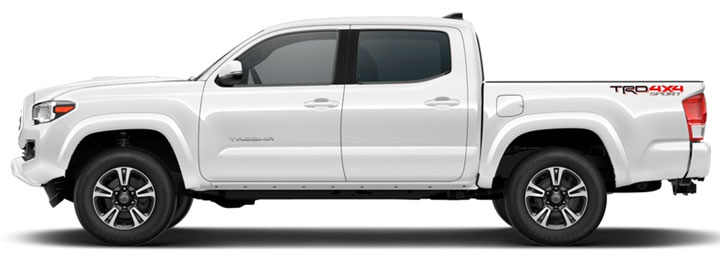
Short beds are 5 to 6 feet long. They’re generally found in midsize pickup trucks like the Toyota Tacoma, Nissan Pathfinder, Chevrolet Colorado, Ford Ranger, and Honda Ridgeline. Normally, you’ll see this bed paired with a full length “crew cab” or “extra cab” (some manufacturers have different terminology).
That aside, this cab designation is when you have a full four doors in your cab for your passengers to to sit in, where they don’t need to deal with a half door like a suicide door in the larger bed models.
You actually can do quite a bit with a 5-6 foot bed. You can throw snowboards in there, throw outdoor gear, camping gear, 150 quart coolers, all the recovery gear you could ever need for offroading, and still have your whole family be comfortable in the five seats with the four full doors.
Standard Bed
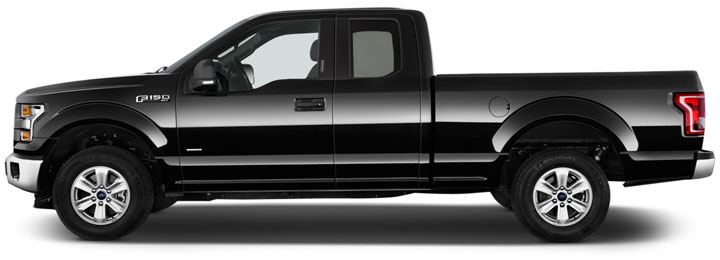
Standard beds are almost always 6 to 6.5 feet long. More often than not, they are accompanied by a crew cab with one normal size door and another door that’s half a door or a “Suicide door“
You can get a standard size bed with a standard size cab with only two doors if you want a shorter wheelbase, which is the preferred size truck for many off-roaders.
With a full-size truck like an F150, Chevy Silverado, Ram 1500, or Toyota Tundra, the standard bed is always accompanied by a crew cab, a standard cab or (single cab), or a full-size cab with a full size bed. The latter yields an extremely long wheelbase.
Generally, a standard size bed is the most useful because a lot of lumber comes in 6 foot increments, it looks proportionate, most people are going to be around 6 foot tall and under which means you can lie down in the back if you plan on camping with a topper, or if you have a slide-in camper as most of them accommodate this size truck bed.
From my experience, a standard bed is about the right size for a pick up truck if you’re going to be using it on the weekends but also want a truck that’s not too long that you can drive every day to and from work.
Long Bed
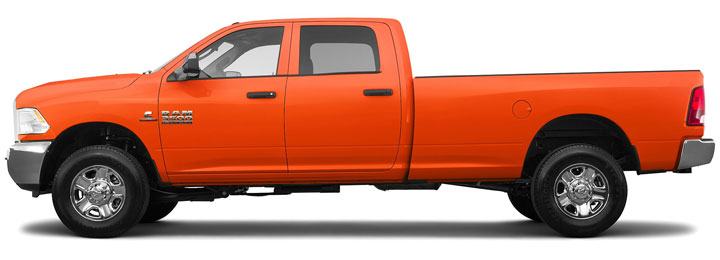
A long bed is normally 8 feet long. This is the preferred length for people who need to do work using their trucks. You can find this length of bed in the F150 long bed, F250, F350, F450, Chevy 2500, 3500, 4500, Dodge work trucks, and many others.
Long beds are perfect for contractors simply because many items they deal with are extremely long. Whether that’s piping, copper, 4′ x 8′ sheets of plywood, 2 x 4s, windows, glass, sheets of drywall, and other things you need to build houses and fix up the communities we live in.
According to my foreman growing up working construction, the only real “working man’s” truck has an 8 foot bed, is four-wheel-drive, is a Ford F250, and has a work cab on the top. The frustrating thing is you can’t get one of those for less than $80,000 these days.
See Also: Why Do Some Truck Have Wheel Spikes?
How Truck Bed Lengths Are Measured
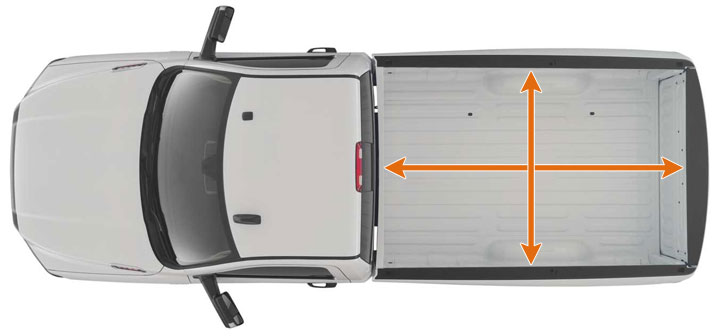
Truck beds are measured by taking the distance between the inside of the bulkhead (the part closest to your cab) and the inside of your tailgate, which is the portion that opens and closes at the back of your truck.
Some think that this measurement is the outside measurement, but this would vary greatly because of the differences in bodywork between manufacturers.
The width of a truck’s bed is measured by taking the inside of the widest part of your truck bed and measuring the distance between that point and the point directly across to the other side.
Many manufacturers have now thrown a wrench in the dimensions of pickup trucks as you may have already found out through ads and commercials. Heard of the “Multi Pro Tailgate” from GMC? It’s a tailgate that offers 7 different ways to flip it up and use it.
With the tailgate down on the 6 foot bed, it turns into a 7 foot long bed, with a flip up tab to keep your motorcycles from rolling out of the back.
Other manufacturers like Dodge offer two side compartments on their beds that allow you to store long objects or recovery gear. However, the addition of these compartments eats into the interior space of the bed, so you might get a bed that’s actually smaller than you thought!
Related: Best Bedliner Kits for Your Truck
Truck Bed Size Dimensions Charts
Chevy/GMC Trucks
| Make | Model | Years | Length | Width | Bed Style |
|---|---|---|---|---|---|
| Chevy/GMC | Colorado/Canyon | 2004-2012 | 60.0" | 57.0" | Short |
| Chevy/GMC | Colorado/Canyon | 2004-2012 | 71.5" | 57.0" | Standard |
| Chevy/GMC | Colorado/Canyon | 2015-current | 61.7" | 57.8" | Short |
| Chevy/GMC | Colorado/Canyon | 2015-current | 74.0" | 57.8" | Standard |
| Chevy/GMC | Silverado/Sierra | 1999-2006 | 77.6" | 49.0" | Sportside |
| Chevy/GMC | Silverado/Sierra | 1999-2006 | 77.5" | 63.7" | Standard |
| Chevy/GMC | Silverado/Sierra | 1999-2006 | 96.6" | 63.7" | Long |
| Chevy/GMC | Silverado/Sierra | 2007-2013 | 68.0" | 63.6" | Short |
| Chevy/GMC | Silverado/Sierra | 2007-2013 | 77.5" | 63.6" | Standard |
| Chevy/GMC | Silverado/Sierra | 2007-2013 | 96.6" | 63.6" | Long |
| Chevy/GMC | Silverado/Sierra | 2014-2018 | 69.3" | 62.3" | Short |
| Chevy/GMC | Silverado/Sierra | 2014-2018 | 78.9" | 62.3" | Standard |
| Chevy/GMC | Silverado/Sierra | 2014-2018 | 97.8" | 62.3" | Long |
| Chevy/GMC | Silverado/Sierra | 2019-current | 69.9" | 63.3" | Short |
| Chevy/GMC | Silverado/Sierra | 2019-current | 79.4" | 63.3" | Standard |
| Chevy/GMC | Silverado/Sierra | 2019-current | 98.2" | 63.3" | Long |
| Chevy/GMC | S-10/Sonoma | 1994-2003 | 72.4" | 56.6" | Standard |
| Chevy/GMC | S-10/Sonoma | 1994-2003 | 88.3" | 56.6" | Long |
| Chevy/GMC | S-10/Sonoma | 2001-2004 | 54.6" | 56.3" | Short |
| Chevy | Avalanche | 2002-2013 | 63.0" | 50.0" | Short |
| Chevy | SSR | 2003-2006 | 48.7" | 56.6" | X-Short |
| GMC | Hummer H3T | 2009-2010 | 59.3" | 44.2" | Short |
| GMC | Hummer H2 SUT | 2005-2009 | 34.7" | 47.3" | X-Short |
Dodge Trucks
| Make | Model | Years | Length | Width | Bed Style |
|---|---|---|---|---|---|
| Dodge | Dakota | 2008-2011 | 63.0" | 57.5" | Short |
| Dodge | Dakota | 2008-2011 | 76.8" | 57.5" | Standard |
| Dodge | Ram 1500/2500/3500 | 1994-2001 | 76.5" | 65.5" | Standard |
| Dodge | Ram 1500/2500/3500 | 1994-2001 | 96.5" | 65.5" | Long |
| Dodge | Ram 1500/2500/3500 | 2002-2008 | 74.5" | 65.5" | Standard |
| Dodge | Ram 1500/2500/3500 | 2002-2008 | 96.5" | 65.5" | Long |
| Dodge | Ram 1500/2500/3500 | 2009-2018 | 74.3" | 65.5" | Standard |
| Dodge | Ram 1500/2500/3500 | 2009-2018 | 96.4" | 65.5" | Long |
| Dodge | Ram 1500 | 2019-current | 67.4" | 66.4" | Short |
| Dodge | Ram 1500/2500/3500 | 2019-current | 76.3" | 66.4" | Standard |
| Dodge | Ram 1500/2500/3500 | 2019-current | 98.4" | 66.4" | Long |
Ford Trucks
| Make | Model | Years | Length | Width | Bed Style |
|---|---|---|---|---|---|
| Ford | Ranger | 1998-2000 | 72.0" | 54.3" | Standard |
| Ford | Ranger | 1998-2000 | 84.0" | 54.3" | Long |
| Ford | F-150 | 1997-2003 | 77.5" | 62.3" | Standard |
| Ford | F-150 | 1997-2003 | 96.2" | 62.3" | Long |
| Ford | F-150 | 2004-2008 | 65.9" | 62.5" | Short |
| Ford | F-150 | 2004-2008 | 77.8" | 62.5" | Standard |
| Ford | F-150 | 2004-2008 | 96.0" | 62.5" | Long |
| Ford | F-150 | 2009-2014 | 65.6" | 62.4" | Short |
| Ford | F-150 | 2009-2014 | 77.5" | 62.4" | Standard |
| Ford | F-150 | 2009-2014 | 95.8" | 62.4" | Long |
| Ford | F-150 | 2015-2020 | 67.1" | 65.2" | Short |
| Ford | F-150 | 2015-2020 | 78.9" | 65.2" | Standard |
| Ford | F-150 | 2015-2020 | 97.6" | 65.2" | Long |
| Ford | F-150 | 2021-current | 65.4" | 65.2" | Short |
| Ford | F-150 | 2021-current | 77.2" | 65.2" | Standard |
| Ford | F-150 | 2021-current | 95.9" | 65.2" | Long |
| Ford | F-250/F-350 | 1999-2007 | 80.8" | 64.8" | Standard |
| Ford | F-250/F-350 | 1999-2007 | 97.0" | 64.8" | Long |
| Ford | F-250/F-350 | 2008-2016 | 80.2" | 64.8" | Standard |
| Ford | F-250/F-350 | 2008-2016 | 96.4" | 64.8" | Long |
| Ford | F-250/F-350 | 2017-current | 81.9" | 66.9" | Standard |
| Ford | F-250/F-350 | 2017-current | 98.1" | 66.9" | Long |
| Ford | Maverick | 2022 | 54.4" | 53.3" | X-Short |
| Ford | Explorer Sport Trac | 2001-2005 | 50.5" | 55.3" | X-Short |
| Ford | Explorer Sport Trac | 2007-2010 | 50.4" | 50.6" | X-Short |
Nissan Trucks
| Make | Model | Years | Length | Width | Bed Style |
|---|---|---|---|---|---|
| Nissan | Titan | 2004-2015 | 65.4" | 61.3" | Short |
| Nissan | Titan | 2004-2015 | 77.3" | 61.3" | Standard |
| Nissan | Titan | 2008-2015 | 84.9" | 61.3" | Standard |
| Nissan | Titan | 2008-2015 | 96.8" | 61.3" | Long |
| Nissan | Titan | 2016-current | 67.0" | 63.8" | Short |
| Nissan | Titan | 2016-current | 78.7" | 63.8" | Standard |
| Nissan | Titan | 2016-current | 97.2" | 63.8" | Long |
| Nissan | Frontier | 2001-2004 | 54.9" | 54.7" | X-Short |
| Nissan | Frontier | 2001-2004 | 73.4" | 54.7" | Standard |
| Nissan | Frontier | 2005-2020 | 58.5" | 58.7" | X-Short |
| Nissan | Frontier | 2005-2020 | 72.5" | 58.7" | Standard |
| Nissan | Frontier | 2021-current | 59.5" | 61.4" | X-Short |
| Nissan | Frontier | 2021-current | 73.3" | 61.4" | Standard |
Toyota Trucks
| Make | Model | Years | Length | Width | Bed Style |
|---|---|---|---|---|---|
| Toyota | Tacoma | 2001-2004 | 60.3" | 57.1" | Short |
| Toyota | Tacoma | 2001-2004 | 73.4" | 57.1" | Standard |
| Toyota | Tacoma | 2005-2015 | 61.0" | 56.8" | Short |
| Toyota | Tacoma | 2005-2015 | 73.9" | 56.8" | Standard |
| Toyota | Tacoma | 2016-current | 60.5" | 55.0" | Short |
| Toyota | Tacoma | 2016-current | 73.7" | 55.0" | Standard |
| Toyota | Tundra | 2000-2006 | 74.4" | 61.4" | Standard |
| Toyota | Tundra | 2000-2006 | 96.3" | 61.5" | Long |
| Toyota | Tundra | 2007-2020 | 64.8" | 62.6" | Short |
| Toyota | Tundra | 2007-2020 | 77.0" | 62.6" | Standard |
| Toyota | Tundra | 2007-2020 | 95.9" | 62.6" | Long |
| Toyota | Tundra | 2021-current | 66.7" | 66.4" | Short |
| Toyota | Tundra | 2021-current | 78.7" | 66.4" | Standard |
| Toyota | Tundra | 2021-current | 97.2" | 66.4" | Long |
Other Trucks
| Make | Model | Years | Length | Width | Bed Style |
|---|---|---|---|---|---|
| Cadillac | Escalade EXT | 2001-2012 | 63.3" | 50.0" | Short |
| Honda | Ridgeline | 2006-2014 | 60.0" | 55.2" | Short |
| Honda | Ridgeline | 2017-current | 64.0" | 60.0" | Short |
| Jeep | Gladiator | 2020-current | 60.3" | 56.8" | Short |
| Lincoln | Blackwood | 2002 | 56.3" | 49.0" | X-Short |
| Lincoln | Mark LT | 2006-2008 | 67.0" | 65.2" | Short |
| Lincoln | Mark LT | 2006-2008 | 78.8" | 65.2" | Standard |
| Mitsubishi | Raider | 2006-2009 | 63.0" | 57.5" | Short |
| Subaru | Baja | 2003-2006 | 41.5" | 39.2" | X-Short |
How to Choose the Right Truck Bed
Choosing the right truck bed is going to be a matter of preference for the consumer at the end of the day.
Do you need to carry a bunch of camping gear? How about some 8 x 4 sheets of plywood? Do you care more about being able to fit people comfortably in the cab of your truck? Or, do you just have one buddy that you take from job site to job site and you really care about having a long slide-in camper?
If you value living room, go with the standard bed, crew cab. This way, you get the benefit of a bed, but you also have plenty of space inside the cabin.
All of the above are questions you’re going to want to answer before you choose what truck you’re going to get. I will also add that it helps to make this decision yourself and not give into peer pressure or what other truck owners think of what a “real truck” is.
If I had to hazard a guess, I would say 9 out of 10 truck owners rarely ever use their bed and that they might be better served with a lot more living space in the cab for passengers or your kids then an extra foot in the bed.
However, if you live out in the country and don’t have the luxury of renting a U-Haul every time you need to get manual labor done, a truck is going to be a vital part of everyday life.
Even if it’s just a “Hey honey, can you go pickup some mulch so we can keep these seeds safe?” You’ll want to have a truck so you can drive directly to place that sells bulk landscaping supplies, have them dump 1/2 a yard of mulch in the back, and drive directly home.
There’s no need to have to borrow a neighbor’s truck, deal with hooking up your utility trailer (if you have one), or renting a truck or trailer.
Have a truck also allows you to have a distinct separation between the “clean” and “dirty” parts of your vehicle. Throw the oil that you need to recycle in the back of the bed instead of the trunk of your sedan. You’ll thank me later when that oil spills.
Pickup Truck Cab Sizes
Regular (Standard) Cab
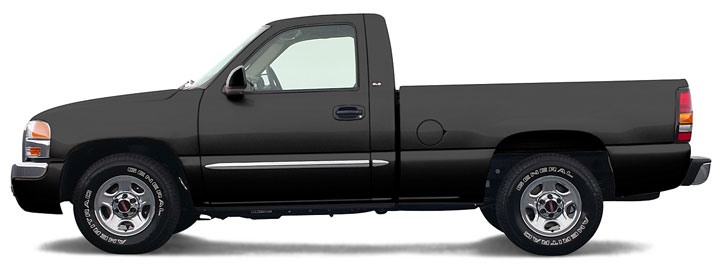
A standard cab is exactly how it sounds: It’s a normal truck cabin with a bench seat for 2 to 3 people. It’s the classic pickup truck cab that allows you and your buddies (or maybe you and your girlfriend) to sit side-by-side as you ramble on the road.
Standard cab sizes allow you to have a longer bed in the back because there simply isn’t enough space for a double cab matched with an 8 foot bed for example. This is also the cab option that is usually offered with the lower priced versions of your truck, so, if you want a standard 6 foot bed, manual transmission, rear-wheel drive Ford F150, it’s probably going to be a standard cab.
Alternatively, if you want the shortest wheelbase 4 x 4, the 6 foot bed Toyota Tacoma from 1990, you’re going to get a standard cab as well and it’s going to be awesome. This is because a short wheel base allows you to turn your truck easier, navigate obstacles, is normally lighter-weight, and they just look plain cool!
Extended Cab
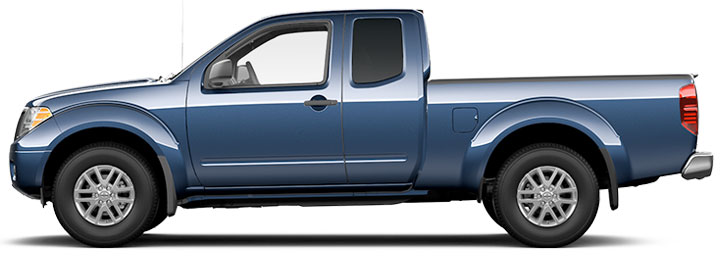
An extended cab is like a standard cab except “extended“. They usually are accompanied with a suicide door behind the standard door and a smaller seat that would fit kids comfortably but might be a little tight for your adult buddies.
Normally this is a good way to get a little bit of extra room in a pinch but it doesn’t increase the wheelbase too much of your vehicle so it’s still pretty comfortable for day-to-day driving when it’s only you in the front seat.
It’s not so short where you only have room for two people like the standard cab mentioned above, but it’s not too long where you’ll have trouble parking in the city.
Double Cab

A double cab is a cab with two full sets of doors, or a cab with two doors that open and close like a normal door but maybe the back two doors are a little smaller than the front two doors.
This cab style is usually accompanied by either a 5 or 6 foot bed to account for the extra length in the cab. This is the option if you choose if you want a truck with room for your family but you don’t want to increase the overall length of your truck at any cost.
Some notable trucks that offer this configuration are the Toyota Tacoma, Ford F150/F250/F350, Nissan Titan, Nissan Pathfinder, Dodge Dakota, Chevy Colorado, and the Ford Ranger.
Read Also: Fuel Economy Numbers for Duramax Engines
Crew Cab

A crew cab is what most manufacturers refer to as their largest cab offering. It will accommodate five full-size adults in the most comfort possible and is the most readily available cab size if you’re going with a short bed.
In a crew cab, you’re either going to be sacrificing how long your bed is in the back of your truck or you’re gonna have a very long vehicle that’s a little bit more difficult to drive in the city streets.
If you need to carry just a couple of coolers, maybe some outdoor gear, tailgating apparel, or just luggage for your in-laws, then the crew cab is gonna be the best bet for you. The occupants will be comfy, and you’ll still have that bed for all your gear.
Crew cab pickups are becoming extremely popular with families as an alternative to full size SUVs.
Mega Cab
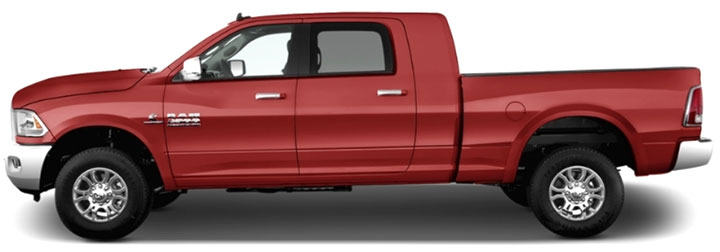
Dodge has recently introduced a new type of cab in 2019 called the “mega“ cab. It limits the length of bed to a 6 foot bed, but offers the passenger a little bit more legroom, more living space, and a general increase in luxury in the interior of the cabin.
While it’s definitely a design dreamt up by the marketing team and doesn’t really offer any improvement over the crew cab, it seems like Dodge truck customers are snapping them up rather quickly.
Final Thoughts
Well, I bet you didn’t think that there were so many options when choosing a pickup truck, but I guess this sort of explains why these trucks (at least in the United States) are the most readily bought and sold vehicles year in and year out.
What are you going to go with? A short bed crew cab or the long bad standard cab rear wheel drive work man’s truck?
I hope this article has helped you decide which direction to go.
